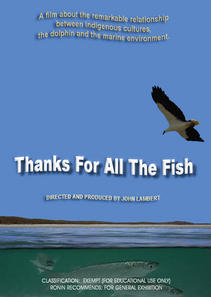Shop for a film
THANKS FOR ALL THE FISH
Year: 2003
Classification: Exempt - Ronin Recommends: G
Runtime: 26 min
Produced In: Australia
Directed By: John Lambert
Produced By: John Lambert, Robin Newell
Language: English
A film about the remarkable relationship between Indigenous cultures, the dolphin and the marine environment. We learn of remarkable signs observed between land and ocean to indicate when fish are travelling and in what numbers, and gain a clear insight into the 'yuri' or totem system and its place in contemporary culture.
In Seaworld on Australia's east coast, a curious-looking old dolphin with a white fin no longer performs for the crowds. She now acts as a nanny and mid-wife for the new born dolphins. 'Amity' is the only such animal in captivity in the world. Across a narrow strip of ocean lies 'Minjerribah', Stradbroke Island, and Amity Point from where she was 'collected'. It's here that 'Amity' leads us into a story as old as the Indigenous people that remain there.
The Aboriginal people of Stradbroke Island would call their local dolphins by striking the surface of the water in a coded rhythm. The dolphins recognised the signal and drove the shoals of fish against the shore and into the waiting nets. A portion of the catch was always given back to the dolphins to show thanks and respect.
By journeying through a fishing season, we are drawn into those Indigenous belief systems that made such a relationship with the dolphins possible.
For many descendants, the dolphins are the reincarnation of their 'clever people', maintaining the laws of the saltwater country. Today, in their traditional country, dolphins perform for the tourist dollar, jet-boats race nets around fish, stocks are depleted, marine mammals have been washed up dead, and dolphins have even been the victim of shootings.
Why did the traditional practices break down, and what role can traditional law play in re-establishing an equilibrium between humans and nature?
Producer, director – John Lambert
Co-producer – Robin Newell
Cinematographers – Peter Pescell, Robin Newell, John Lambert
Editors – Brad Lindenmayer, Ken Sallows, Tim Lewis
Produced in association with Australian Film Commission
Produced in association with Pacific Film and Television Commission
Permalink: https://www.roninfilms.com.au/feature/686

